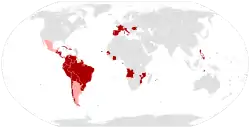Latin Union
The Latin Union was an international organization of nations that used Romance languages that existed as a functional institution from 1983 to 2012. Headquartered in Paris, France, its aim was to protect, project, and promote the common cultural heritage of Latin peoples and unifying identities of the Latin, and Latin-influenced, world. It was created in 1954 in Madrid, Spain, and its membership rose from 12 to 36 states, including countries in North America, South America, Europe, Africa, and the Asia-Pacific region.[2]
| 1954–2012 | |
 | |
| Headquarters | Paris, France 48°46′N 2°11′E |
| Official languages | |
| Members[1] |
|
| Leaders | |
• President of the Congress | Oleg Serebrian |
• Secretary-General | José Luis Dicenta Ballester |
| Historical era | Cold War |
• Established | 15 May 1954 |
| 31 July 2012 | |
Website www | |
The official names of the Latin Union were: Union Latine in French, Unione Latina in Italian, União Latina in Portuguese, Uniunea Latină in Romanian, Unión Latina in Spanish, and Unió Llatina in Catalan.[3]
Due to financial difficulties, the Latin Union announced on 26 January 2012 the suspension of its activities, the dissolution of its Secretariat General (effective 31 July 2012) and termination of employment for all the organization's personnel.[4]
Membership
According to the Latin Union's website, membership was open to any nation that met the following criteria:
- Linguistic criteria :
- Official language derived from Latin
- Latin-derived language used in education
- Latin-derived language commonly used in the mass media or in daily life
- Linguistic/cultural criteria :
- Existence of significant literature in a Latin-derived language
- Press and publication in Latin-derived language
- Television with a strong proportion of the programming in a Latin-derived language
- Radio widely broadcast in a Latin-derived language
- Cultural criteria :
- Direct or indirect inheritance of the legacy of Ancient Rome, to which the state remains faithful and which it perpetuates mainly through the education of Latin
- Cultural education of Latin-derived foreign languages
- Exchange programmes with other Latin countries
- Societal organization, particularly in the legal plane, based on respect for fundamental liberties, the general principles of human rights and democracy, tolerance, and freedom of religion
Official languages
The official languages of the Latin Union were Spanish, French, Italian, Portuguese, Romanian, and Catalan. Spanish, French, Italian and Portuguese were used as working languages. All the texts of general diffusion were translated into these four languages, with some also going into Romanian and Catalan.
Member states
Catalan
 Andorra
Andorra- Catalan is also co-official in Catalonia, Valencian Community, Balearic Islands and some other areas of Spain and in Alguer (Italy).
- Also spoken in Pyrénées-Orientales, France.
Organization
The Union was composed of three main bodies, namely, the Congress, the Executive Council, and the General Secretariat.
Congress
The Congress, which consisted of the representatives of all the Member States, met in ordinary assembly every two years. Its main functions were
- to adopt the budget,
- to define the general direction of the Union,
- to receive the new Member States formally, and
- to elect and appoint different Member States to be the Presidents, Vice-Presidents, and members of the sub-organisations of the Union.
A President and two Vice-Presidents were also elected by the Congress. Oleg Serebrian from the Republic of Moldova was the last President.
There were also two auxiliary bodies of the Congress, namely, the Commission of Adhesions and the Commission of Candidacies.
- The Commission of Adhesions was composed of 10 Member States and was responsible for promoting the adherence of all the Member States of the Union.
- The Commission of Candidacies was composed of 9 Member States and was responsible for examining the validity of the candidacies, taking account of the geographical and linguistic-cultural division.
Executive Council
The Executive Council was the executive branch of the Union. It consisted of 12 Member States, which were elected by the Congress every four years, and led by a President and two Vice-Presidents, which were also elected by the Congress.
There were also two auxiliary commissions sub-ordinated to the Executive Council:
- The Commission of Finance and Programmes
- The Commission of Statues
General Secretariat
The Latin Union was directed by a Secretary-General appointed every four years by the Congress. The Secretary was in charge of the execution of the programmes and implemented the decisions made by the Congress and the Executive Council in the matter of budget and general direction. Jose Luis Dicenta Ballester was at one time Secretary-General of the Union.
Subordinated to the Secretary-General, there were 4 directors:
- Director of Administration and Finance
- Director of Culture and Communication
- Director of Promotion and Education of the Languages
- Director of Terminology and Industry of the Language
Finance
The finance of the Union was mainly supported by the obligatory contributions from the Member States. For some activities, the Union may have collaborated with other public or private institutions.
See also
- Association of Spanish Language Academies
- Community of Portuguese Language Countries
- Francophonie
- Hispanic
- Lusophone World
- Hispanidad
- Hispanic America
- Ibero-America
- Latin America
- Latin Europe
- Latin Monetary Union
- Italic peoples
- Romance peoples
- Organization of Ibero-American States
- Panhispanism
- Pan-Latinism
- Romance languages
- Romance-speaking Africa
- Romance-speaking Europe
- Romance-speaking world
References
- "États membres". Latin Union. Retrieved 2013-12-06.
- "Unión Latina; Estados miembros". Archived from the original on 2008-12-28. Retrieved 2009-01-05.
- Latin Union Official Site Archived 2009-05-12 at the Wayback Machine
- "Disolución de la Secretaría General de la Unión Latina", Unión Latina, accessed 2012-06-10.
External links
- (in Spanish, French, Italian, Portuguese, Romanian, and Catalan) Official site